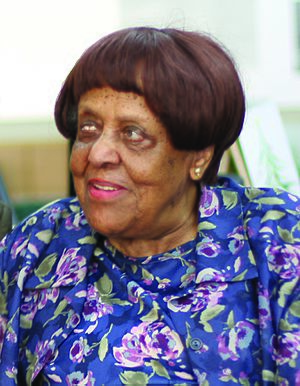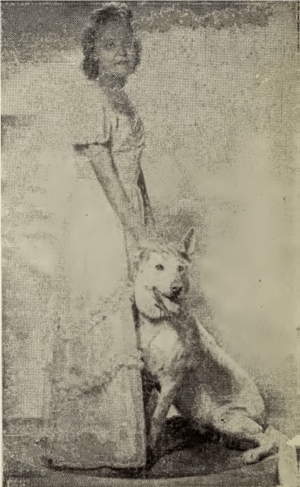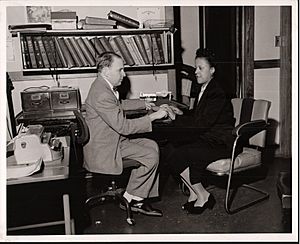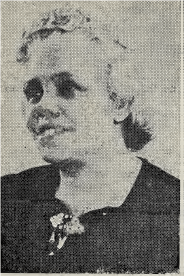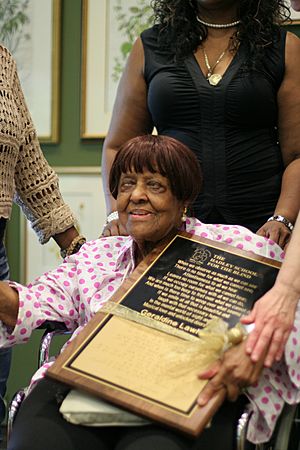Geraldine Lawhorn facts for kids
Geraldine Jerrie Lawhorn (born December 31, 1916 – died July 3, 2016) was an amazing American woman. She was deafblind, meaning she couldn't see or hear. Jerrie was a talented performer, actress, and pianist. Later, she became a teacher at the Hadley Institute for the Blind and Visually Impaired. When she was 67 years old, she made history. She became the first deafblind African American person to earn a college degree in the United States.
Contents
Her Life Story
Early Years
Geraldine Jerrie Lawhorn was born on December 31, 1916, in Dayton, Ohio. Her parents, Pearl Walker and William Bert Lawhorn, were musicians. At the time, they managed a movie theater in Dayton. Jerrie had two older brothers, Melvin and Wendell.
Jerrie spent her early childhood moving between Dayton and Chicago. When she was about 18 months old, her family moved to Chicago. There, they started a candy business. After her parents divorced in 1922, Geraldine went back to Dayton with her mother. She started elementary school there. However, a difficult experience made them move back to Chicago. She lived there with her mother and brothers. During the Great Depression (which started in 1929), the Lawhorn family faced tough times financially. To help out, Pearl Walker opened a beauty shop in their apartment. This allowed her to earn money and care for her children.
Losing Sight and Hearing
When Geraldine was about eight years old, doctors found she had an eye problem. She couldn't see well and had trouble reading. Her parents, hoping for a miracle, took her to many church meetings. At twelve, Geraldine lost her sight completely, though she could still see some light. Doctors never found out why she became blind.
Because of her blindness, she went to the Sight-Saving Room at Sherwood Grammar School. This special room helped visually impaired students. Geraldine had to learn braille, a system of reading with touch. But she still had classes with students who could see. School wasn't always easy. In eighth grade, some classmates were mean to her.
Later, Geraldine attended the Braille Department at Marshall High School. She became very interested in writing and public speaking. She won several awards for her short stories. She even changed her name from "Jerry" to "Jerrie" because she thought it sounded more French! As time went on, Jerrie slowly lost her hearing too. She had to learn a new way to communicate: the One-Hand Alphabet. She joined a special program for deafblind students. Even with these challenges, she kept improving her writing. She won a writing contest in Chicago for her short story called Gift.
Artistic Life
Geraldine graduated from high school with excellent grades. She received a scholarship from the AKA sorority. She decided to take a writing course by mail from Columbia University. The Hadley Institute helped by providing the course materials in braille. Around this time, Jerrie volunteered for a project to see if dogs could guide blind people. She received a dog named Blondie, and after a few months, she was allowed to keep her.
At 19, Jerrie completely lost her hearing. Doctors thought it was because of measles she had when she was five. This was a very sad time for her. But Jerrie didn't give up. She got involved in many activities. She joined the Fellowship Circle of the Blind. There, she discovered drama performance and started writing plays. She performed her first full dramatic show on May 2, 1940, at Poro College.
Jerrie wanted to go to college, but many scholarships turned her down because of her disabilities. So, she decided to focus on her artistic talents. She received a grant to take private theater arts lessons. She went to the Chicago Piano College three days a week. Bessie Henderson, a teacher there, taught her creative writing, clear speaking, and acting. Geraldine also took music lessons once a week. This was hard because she couldn't hear the piano, but she said she could feel its vibrations.
In 1942, Geraldine was accepted into the American Conservatory of Music in Chicago. She studied there for four years. She performed monologues for United Service Organizations programs. She also volunteered for the Red Cross and received a medal for her hard work. Jerrie even auditioned for a radio show in Chicago. She didn't win, but she became well-known. She appeared on TV shows like Someone You Should Know, The Phil Donahue Show, and Ripley's Believe It or Not.
Moving to New York City
In 1946, Geraldine and her mother moved to New York City. They stayed with Frank Wilson, a Broadway actor known for helping young talents. Sadly, Jerrie's guide dog, Blondie, died shortly after they arrived. This made Jerrie very sad for a long time.
Frank Wilson gave Geraldine chances to perform on stage. Her first show in New York City was at his church, and her second was at Carnegie Recital Hall. She even met famous actors backstage after seeing the musical South Pacific. Jerrie and her mother planned to stay only for a summer, but her growing fame made them stay for two years.
Jerrie didn't have a manager. She and her mother, Pearl, managed her career. The money she earned from shows helped her take private theater lessons. She also took speech lessons to control her voice. Her mother and Frank Wilson would listen to the audience's comments to help Geraldine improve. Jerrie's shows were inspired by New York street artists, her surroundings, and her daily life. Her one-woman show was called Projected Hearts. She performed at Carnegie Recital Hall, dedicating her shows to Frank Wilson after he passed away. She also performed at the 1964 New York World's Fair with a group called the Celestial Choral Ensemble of the Blind.
In 1948, Geraldine and her mother moved out of Wilson's house. They found an apartment in Long Island City. Their old neighbors helped them move and even gave them furniture, including a piano. Jerrie was active in many community groups. She joined a program for disabled adults where she learned swimming, bowling, ceramics, aerobics, and social dancing like rumba and tango. She also took piano lessons and learned to read braille music. These new skills led her to study piano techniques at the New York College of Music.
A Dream of College
At this time, only a few deafblind people had earned a college degree, like Helen Keller. Jerrie really wanted to get a degree too. However, her advisor told her to use her scholarship for theater skills instead. So, she enrolled at the Brown Adams Professional Actors Studio. Geraldine appeared on TV shows and won awards, like the Best One-Woman Show award from Show Business magazine. Ebony magazine even wrote a long article about her life. Jerrie also wrote for braille magazines and short stories for Skylark.
In 1966, Geraldine was invited to the 100th birthday celebration of Anne Sullivan, who was Helen Keller's teacher. At this event, eight deafblind adults, including Geraldine Lawhorn, received the Anne Sullivan Gold Medal. During the event, Richard Kinney, the president of the Hadley Institute, invited Geraldine to become a teacher there. She was unsure at first because she loved her career in New York. But she also worried about her mother, who was getting older and needed to be near family. Finally, she accepted the teaching job.
Returning to Chicago
In 1967, Pearl Walker and Geraldine moved back to Chicago. Geraldine didn't start teaching right away. First, she went through a training program in New York. After that, she began teaching two courses by mail: "Independent Living for Those Without Sight or Hearing" and "Verse Writing and Poetry." The poetry courses were free, and many students signed up.
Geraldine still gave presentations and speeches. She was a main speaker at a big conference in Chicago for people who work with the blind and visually impaired.
Less than two years after moving back to Chicago, Pearl Walker had a stroke. She was in the hospital for a month and was paralyzed on her left side. She had to do months of rehabilitation. Geraldine's family was very supportive. Geraldine used special tools to communicate with her mother. Sadly, Pearl had another stroke in 1972 and passed away. After her mother's death, Geraldine started using new equipment to be more independent. This included a special phone attachment for deafblind people and a device that activated appliances when the phone rang. The Hadley School also gave her an Optacon to read printed materials.
Geraldine remained very active. She attended conventions for deafblind people and celebrations for Helen Keller's birthdays. She also worked with older people and deafblind families, offering great support.
Achieving Her College Degree
Getting a college degree was a huge goal for Geraldine, and she was determined to do it. She learned about a program called "University Without Walls" and was accepted into Northeastern Illinois University.
On March 23, 1983, Geraldine presented her final project and passed her exams. She earned her bachelor's degree in helping deafblind adults from Northeastern Illinois University. The graduation ceremony was on June 12, 1983, and three TV channels filmed it! At 67 years old, Geraldine became the first deafblind African-American person to graduate from college. She was also the sixth deafblind person in the United States to achieve this.
Three days later, Geraldine was interviewed on the national TV show Good Morning America. On June 17, 1983, she received a letter from President Reagan congratulating her. Later, a famous speaker named Zig Ziglar mentioned Geraldine in his book as an example of never giving up. Geraldine continued to be active in the deafblind community. She encouraged deafblind people to "keep trying." In 1991, she wrote her autobiography called On Different Roads. She believed that people have the same goals but take different paths to reach them.
Later Years and Legacy
In the 2000s, Geraldine traveled across the United States. She taught people how to educate deafblind individuals. She lived alone in her apartment and used special tools, like Braille cooking utensils, every day. She wished she could drive and do even more for the deafblind community. Still, she was thankful for her life and said, "I enjoy what I get and I don't worry about the rest."
The director Sanjay Leela Bhansali said Geraldine's autobiography inspired his 2005 film Black. That same year, Geraldine received an award in Chicago.
In 2011, Jerrie Lawhorn retired from the Hadley Institute after 40 years of teaching. That same year, she was named "Winnetka Teacher of the Year." She received many other awards during her lifetime. She was inducted into the Disabled Persons Hall of Fame in Chicago. She also served on the Illinois Advisory Board for Services for Persons Who are Deaf-Blind.
Geraldine Lawhorn passed away on July 3, 2016, in Chicago. Her friends, family, and students remembered her as an open, joyful, and optimistic woman. Miss Lawhorn left all her belongings to the Hadley Institute for the Blind and Visually Impaired.
Images for kids
See also
 In Spanish: Geraldine Lawhorn para niños
In Spanish: Geraldine Lawhorn para niños


